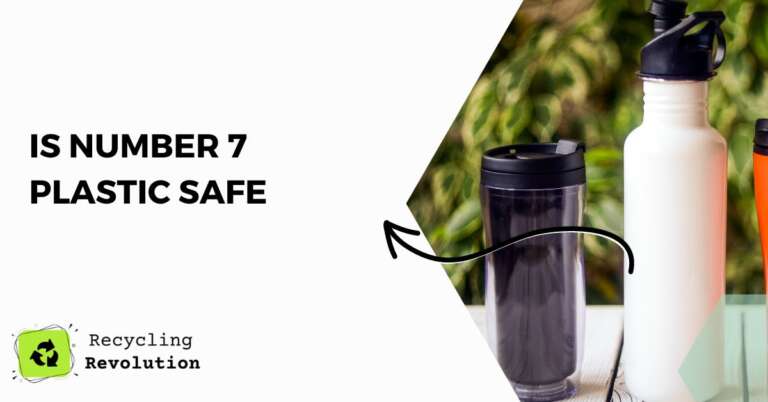Have you ever glanced at the bottom of your water bottle or take-away container, noticing a tiny number encapsulated within a triangle, and wondered what it signifies?
This article aims to shed light on one such symbol: Number 7 plastic. Is Number 7 plastic safe?
TL;DR: Number 7 plastic, a catch-all category encompassing various plastic types, often contains Polycarbonate (PC) and BPA, linked with potential health risks. While the complete avoidance of Number 7 plastic might be challenging, I recommend limiting exposure and considering safer alternatives when available.
🧴 Plastic Recycling Estimator
🔍 Plastic Buyback Facts
Most buyback programs accept PET (water bottles), HDPE (detergent containers), and PP (caps, cups). Light plastics like bags and wrappers are harder to recycle, but containers and jugs are highly valued. Recycling plastic reduces landfill overflow and saves fossil fuels.
Understanding 7 Plastic
Number 7 plastic, also known as “Other” in the resin identification coding system, is a mixed bag. This category includes different types of plastics not classified under numbers 1 to 6. Polycarbonate (PC) and ABS (Acrylonitrile Butadiene Styrene) are common materials found in this group.
Many of these plastics are characterized by their strength, heat resistance, and versatility, making them popular choices for various applications, including water bottles, baby bottles, and food containers.
The Potential Dangers of Number 7 Plastic
One of the main causes for concern with Number 7 plastic is the presence of Bisphenol A (BPA). BPA is a chemical used in the production of certain plastics, including polycarbonate, and can leach into food and beverages stored in containers made from these materials.
According to research, BPA exposure can potentially interfere with the body’s hormonal system. Potential health risks include:
- Endocrine disruption
- Developmental problems in children
- An increased risk of certain cancers
- Heart problems
Note: The Food and Drug Administration (FDA) currently maintains that BPA is safe at the low levels that occur in some foods. However, they also encourage manufacturers to move towards BPA-free alternatives.
How to Limit Exposure to Number 7 Plastic
I recommend several strategies to limit your exposure to potential hazards associated with Number 7 plastic:
- Check for the recycling symbol: Before purchasing plastic items, look for the recycling symbol on the bottom. If it’s labeled with the number 7, consider looking for alternatives.
- Avoid microwaving food in Number 7 plastic containers: Heat can increase the rate at which BPA leaches into food and beverages.
- Be mindful with dishwashing: Similar to microwaving, the intense heat of the dishwasher can increase BPA leaching. Consider hand washing items made from Number 7 plastic.
- Prioritize BPA-free products: Many manufacturers now produce BPA-free items. Look for labels indicating that a product is BPA-free.
Identifying Number 7 Plastic in Everyday Items
Given the health risks associated with Number 7 plastic, it’s important to know how to identify these plastics in everyday items. They can be found in a wide range of products due to their strength, heat resistance, and versatility. Common items include:
- Sports drink bottles
- Canning jar lids
- Food storage containers
- Compact discs
- Eyeglasses
- Baby bottles
To identify Number 7 plastic, look for a triangle with the number 7 in the middle, typically found at the bottom or back of the item. Remember, not all Number 7 plastics contain BPA, but given that this category is a catch-all for many different types of plastic, it’s generally best to proceed with caution.
The Debate on Number 7 Plastic Safety
While several studies point to potential health hazards associated with BPA found in some Number 7 plastics, it’s crucial to mention that not all authorities agree on the level of risk.
The FDA maintains that BPA is safe at the low levels that occur in some foods. However, the National Institute of Environmental Health Sciences part of the National Institutes of Health (NIH) suggests minimizing BPA exposure, especially for infants and children.
This discrepancy can be confusing, and it highlights the ongoing research and evolving understanding surrounding BPA and plastic safety in general. Therefore, I recommend a precautionary approach until further research gives a clear answer.
Impact of Number 7 Plastics on the Environment
Aside from the potential health risks, Number 7 plastics also present significant environmental concerns. These plastics are difficult to recycle due to their mixed composition. As a result, many end up in landfills or, worse, in the natural environment, contributing to the global problem of plastic pollution.
Number 7 plastics, like all plastics, are made from non-renewable resources, primarily petroleum and natural gas. The extraction and processing of these raw materials, along with the manufacturing of the plastic itself, all contribute to greenhouse gas emissions and global climate change.
It’s essential to consider these environmental impacts in addition to the health concerns when deciding whether to use Number 7 plastics.
Moving Towards a Plastic-Free Lifestyle
While completely eliminating plastics from your life might seem overwhelming, every little step counts. Start by making simple switches like carrying a reusable water bottle or shopping bag. When shopping, look for items packaged in cardboard or glass instead of plastic.
With awareness and effort, we can reduce both our exposure to potentially harmful substances in plastics and our contribution to plastic pollution.
Bioplastics – A Possible Future
There’s a rising interest in bioplastics – plastics made from renewable sources like corn starch or sugarcane – that promise to be a more sustainable and potentially safer alternative. Some bioplastics fall under the Number 7 category but are generally marked as “PLA” (Polylactic Acid) or with “Compostable” labels.
While they present a promising future, it’s important to understand that not all bioplastics are created equal. Some might still present health concerns, and their compostability often depends on specific industrial composting facilities. Therefore, it’s essential to research different types of bioplastics and their proper disposal methods.
I recommend continuing to follow developments in this area, as innovation in bioplastics might offer better solutions in the future.
Safer Alternatives to Number 7 Plastic
Switching to safer alternatives is a great way to mitigate potential risks associated with Number 7 plastic. I recommend the following:
- Glass containers: Glass is a non-reactive material, meaning it won’t leach any substances into your food or beverages.
- Stainless steel bottles: For beverages, particularly for hot ones, stainless steel bottles are a good alternative.
- Plastics with recycling codes 1, 2, 4, or 5: These are generally considered safer options, as they don’t typically contain BPA. However, it’s always good to double-check with manufacturers.
- Silicone containers: Silicone is becoming a popular choice for food and beverage storage due to its safety and durability.
Conclusion
Number 7 plastic, a broad category containing various types of plastics including Polycarbonate (PC) and ABS, is linked with potential health risks, mainly due to the presence of BPA. While authorities such as the FDA assert that BPA is safe at low levels, the inconsistency in viewpoints and potential health hazards prompt a precautionary approach.
Number 7 plastics also present significant environmental challenges, contributing to pollution and climate change. Steps such as avoiding microwaving food in these containers, prioritizing BPA-free products, and moving towards safer alternatives like glass, stainless steel, or certain recyclable plastics can mitigate these risks.
The burgeoning field of bioplastics offers promising future prospects, though continued research and innovation are required. Overall, awareness, conscientious choices, and gradual shifts towards plastic-free alternatives can significantly reduce both the health risks and environmental impacts associated with Number 7 plastics.
FAQs
Is Number 7 plastic always unsafe?
No, not all Number 7 plastics are unsafe. This category includes various plastics, and only certain types, like polycarbonate, contain BPA. However, since it’s difficult to know exactly what a Number 7 plastic item contains, it’s best to be cautious.
Is BPA-free plastic safe?
BPA-free doesn’t always mean safe. Some BPA-free plastics may contain other potentially harmful chemicals. It’s best to use alternatives like glass or stainless steel when possible.
Can I microwave food in Number 7 plastic containers?
It’s best not to, as heat can increase the rate of BPA leaching. Use microwave-safe glass or ceramics instead.
How can I reduce exposure to BPA and other potentially harmful chemicals from plastics?
Limit the use of plastic containers, especially for hot food or drinks. Use alternatives like glass, stainless steel, or BPA-free plastics. Also, avoid microwaving or dishwashing plastic containers.

